(Reuters) – Tesla Inc Chief Executive Elon Musk promises to unveil a third part of his Master Plan on March 1, in which he has set out bold goals for growth of the electric-car maker.
PART I (2006) – THE SECRET TESLA MOTORS MASTER PLAN (JUST BETWEEN YOU AND ME):
BUILD SPORTS CAR AND AFFORDABLE EVs
Before Tesla put out its first production car, Musk set expectations for three: a sports car, a cheaper four-door family car and an even more affordable third model.
The plan was unveiled in 2006 and the first model, the Roadster sports car, rolled out in 2008 at a price of $89,000. In 2012, Tesla launched the Model S at a base price of $57,400, and five years later, it released the Model 3 at a then price of $35,000.
The plan did not mention Model X, which was released in 2015.
PROVIDE ZERO-EMISSION ELECTRIC POWER GENERATION OPTIONS
Taking aim at the argument that EVs relied on polluting power plants, Musk said Tesla would sell sustainable energy products from SolarCity — the solar panel and storage equipment maker it bought in 2016.
The plan did not set target times or sales goals.
PART II (2016) – MASTER PLAN PART DEUX:
EVs ACROSS SEGMENTS
In this iteration, Musk said he wants Tesla to address all major vehicle segments from consumer vehicles to heavy-duty trucks and urban transport.
Tesla, as of now, has products in the compact SUV and sedan segments, as well as the premium sedan and SUV categories.
It has yet to start production of the long-delayed Cybertruck, which was unveiled in 2019. The automaker also started limited deliveries of the Semi truck in December, which was originally intended to launch in 2019.
Tesla has provided very few details on the urban transport vehicle.
SOLAR ROOFS AND BATTERY STORAGE
Musk had also planned to create an integrated solar product that would generate power through solar panels on roofs and store energy in batteries.
The company now bundles solar panels from SolarCity with Tesla’s Powerwall battery product to provide the service.
Solarcity accounted for a third of the solar panel market in 2015, but its share has declined sharply over the years to just 0.2% in 2021, according to analytics firm Wood Mackenzie.
SELF-DRIVING CAPABILITY
Tesla has yet to achieve self-driving capabilities and the company’s autonomous driving features, Autopilot and Full Self-Driving (FSD), are under the scrutiny of U.S. regulators.
Musk had first estimated in 2015 that Tesla vehicles would be able to drive themselves by 2018. He has since made that promise multiple times over the years with different timelines.
ENABLE CAR TO MAKE MONEY
“Since most cars are only in use by their owner for 5% to 10% of the day, the fundamental economic utility of a true self-driving car is likely to be several times that of a car,” Musk had said in his plan.
But Tesla is yet to unveil a detailed plan for its ride-sharing and robotaxi services.
(Reporting by Akash Sriram, Tiyashi Datta and Samrhitha Arunasalam in Bengaluru; Editing by Krishna Chandra Eluri)

